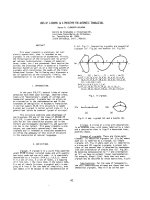báo cáo khoa học: " Advantages of cone beam computed tomography (CBCT) in the orthodontic treatment planning of cleidocranial dysplasia patients: a case report" ppsx
Bạn đang xem bản rút gọn của tài liệu. Xem và tải ngay bản đầy đủ của tài liệu tại đây (1.98 MB, 9 trang )
CAS E REP O R T Open Access
Advantages of cone beam computed
tomography (CBCT) in the orthodontic treatment
planning of cleidocranial dysplasia patients:
a case report
Domenico Dalessandri
1,3*
, Laura Laffranchi
1,3
, Ingrid Tonni
3
, Francesca Zotti
3
, Maria Grazia Piancino
2
,
Corrado Paganelli
3
, Pietro Bracco
2
Abstract
Our aim was to discuss, by presenting a case, the possibilities connected to the use of a CBCT exam in the dental
evaluation of patients with Cleidocr anial Dysplasia (CCD), an autosomal dominant skeletal dysplasia with delayed
exfoliation of deciduous and eruption of permanent teeth and multiple supernumeraries, often impacted. We think
that CBCT in this patient was adequate to accurately evaluate impacted teeth position and anatomy, resulting thus
useful both in the diagnostic process and in the treatment planning, with an important reduction in the radiation
dose absorbed by the patient.
Background
Cleidocranial dysplasia (CCD), also known as cleidocra-
nial dysostosis or Marie-Sainton syndrome, is a disorder
that affects most prom inently those bones derived from
endochondral and intramembrano us ossification and it’s
characterized by defective development of the cranial
bones and by the complete or partial absence of the cla-
vicles. Diagnosis is based on clinical and radiographic
findings, that include imaging of the cranium, thorax,
pelvis and hands. Frequently these patients presents a
delayed ossification of the skull f ontanels and a prema-
ture closing of the coronal suture that leads to a frontal,
parietal and occipital bossing of the skull; a short sta-
ture, occasionally accompanied by a spinal scoliosis; a
wide and flat nasal bridge due to hypertelorism; different
anomalies of pubis and hipbone, with flat feet and knock
knees; a b rachycephaly with an high arched palate and
sometimes cleft palate; a prolonged retention of d ecid-
uous teeth and several impacted permanent successors
and supernumerary elements, sometimes accompanied
by follicular cysts and eruptive pseudocysts [1,2]. This
pathology is transmitted as an autosomal dominant trait
or it’scausedbyaspontaneousgeneticmutationandis
present at a frequency of one in one million individuals.
To date, RUNX2(CBFA1) is the only gene known to be
associated with CCD; although not all cases clinically
diagnosed have mutations in RUNX2, there is little addi-
tional evidence for locus heterogeneity. Mutations in
RUNX2 have a hi gh penetrance and extreme variability.
CCD affects all ethnic groups [3,4].
Although the spectrum of phenotypic variability in
CCD ranges from primary dental anomalies to all CCD
clinical features plus osteoporosis, no clear phenotype-
genotype correlation has been established [5].
Children with CCD should be monito red for orthope-
dic complications, dental abnormalities, upper airway
obstruction, sinus and ear infections, hearing loss, and
osteoporosis.
Intelligence is normal in individuals with classic CCD
The most import ant dental problem associated with t his
syndrome is the malocclusion and the crowding of the
dental arches caused by the retention of multiple decid-
uous teeth and the presence of several supernumerary.
These supernumerary, associated with a diminished
* Correspondence:
1
Doctoral School in “Medicine and Experimental Therapy”, Specialisation in
“Physiopathology of Mastication and the Stomatognathic Apparatus. Dental
Materials”, XXIII cycle, Department of Biomedical Sciences and Human
Oncology, University of Torino, Italy
Full list of author information is available at the end of the article
Dalessandri et al. Head & Face Medicine 2011, 7:6
/>HEAD & FACE MEDICINE
© 2011 Dalessandri et al; licensee BioMed Central Ltd. This is an Open Access article distributed under the terms of the Creative
Commons At tribution License ( which permits unrestricted use, distribution, and
reproduction in a ny medium, provided the original work is properly cited.
alveolar bone resorption, also lead to t he impaction or
the ectopic location of the permanent teeth [6,7].
The previous approach to the dental problems of
these patients consisted in no treatment or in the
extracti on of the impacted or malformed teeth and their
prosthetic replacement [8,9], with a consequent impor-
tant bone loss.
Inthelastyearsamoreconservativeapproachhas
been developed, combining orthodontics and maxillofa-
cial surgery. Orthodontic treatment consist i n the
extraction of the supernumerary teeth and the decid-
uous with delayed exfoliation, followed by the surgical
exposure of impacted permanent teeth and their ortho-
dontic guided eruption. Extractions are not acc om-
plished in o ne time: there must be a staged approach in
order to maintain the vertical occlusal dimension while
the different groups of unerupted teeth are exposed and
pulled in their ideal position.
If there isn’t any, or just a mild, skeletal discrepancy
between maxilla, mandible and cranium, the treatment
is finished with the alignment of all permanent teeth,
obtaining a correct occlusion and an agreeable smile
aesthetics ([10].
In presence of an important skeletal discrepancy, most
comm only a mandibular prognathism, that preclude the
possibility to achieve an acceptable orthodontic camou-
flage, it’s necessary to wait until the completion of skele-
tal growth and then restoring a correct bone position
through orthognatic surgery, followed by the orthodon-
tic finishing [11-14].
Traditional dental radiographs are very useful tools for
the diagnosis of CCD, permitting to observe two fea-
tures of the classical triad considered pathognomonic
for diagnosis of this syndrome: multiple supernumerary
teeth and open suture and fontanels of the skull (the
third sign is the partial or complete absence of the clavi-
cles) . They also show other features helping in the diag-
nostic process like the presence of impacted teeth, the
underdevelopment of maxillary sinuses and the paralle-
lism of mandibular ramus, with an upward and poster-
iorly pointing coronoid process [15].
Unfortunately, especial ly wh en there are a lot of super-
numerary teeth, traditional dental radiographs are not
enough rich in details to allow correct planning the
orthodontic treatment of patients in late mixed dentition.
In these cases it’s appropriate to use a multi-sl ice com-
puted tomography (MSC T) scanner with an accurate tri-
dimensional information regarding the anatomy of every
single tooth, the spatial relation between adjacent teeth
and face to the surrounding anatomical structures.
These data are of crucial importance in order to perform
the best orthodontic treatment for different reasons: they
permit to surely identify the supernumeraries teeth, often
with some hidden malformations like dilacerations or
dental invagination; t hey give the exact position of t he
impacted teeth in relation to the roots o f the adjacent
erupted teeth, preventing damage of these roots during
the forced orthodontic eruption of the impacted teeth; and
they also define the position of every t ooth inside the
alveolar bone and near some important vascular vessels
and nerve fibers, avoiding unexpected complications dur-
ing the extraction or the surgical exposition of impacted
teeth, like bone fracture, local hemorrhage or denervation.
UnfortunatelyaconventionalMSCTexamexposethe
patient to an high dose of x-ray, thereby limiting the appli-
cation of this techniques only to the most complex cases.
Recently a relatively new technique, the CBCT, redu-
cing the dose of radiation adsorbed by the patient, had
been improved by different manufacturer, obtaining
good quality images. The principal difference between
MSCT and CBCT is that conventional CT uses a fan of
x-rays and a narrow detector, so multiple slices are
stacked to obtain a complete image, whereas CBCT use
a cone of x-rays and a two-dimensional square detector
allowing a single rotation of the radiation source to cap-
ture an entir e region of interest: hereby t he total radia-
tion is less important than with conventional CT [16].
Case Report
A 15-year-old man, with a diagnosis of Cleidocranial
dysplasia, was referred to our departme nt for orthodon-
tic treatment. The patient was previously treated only
with deciduo us and supernumerary teeth extraction and
four panoramic x-ray were taken in the last two years in
order to check teeth development and eruptive direction
(Figure 1, 2, 3, 4).
Oral examination revealed a bilateral cross bite with
marked teeth misalignment
Old radiograms examination shows the presence of several
supernumeraries and impacted teeth: we were able to esti-
mate the number of impacted teeth but it was not possible
to exactly evaluat e their morphology, in order to detect
possible root reabsorption areas and to establish which
were supernumeraries teeth and which not, and the ir
Figure 1 Orthopantomography at 13 years 2 months of age.
Dalessandri et al. Head & Face Medicine 2011, 7:6
/>Page 2 of 9
anatomical relationship with other teeth and with some cri-
tical structures like mandibular nerve and foramen.
On the basis of these findings a three-dimensional
CBCT scan was obtained, in order to exactly recognize
teeth anatomical anomalies, to decide which of them are
to be extracted and to plan the surgical access.
We decided to use the NEWTOM 3G (QR, Vero na -
Italy) scanner and we choose the spherical field of view
(FOV) of 9” (medium FOV) in order to obtain an image
of only maxillary, m andibular and TMJ region with a
unique acquisition. The scan was completed within
36 seconds and the time of exposure was of 3,6 seconds.
The tube voltage was of 110 kV and the tube current
was of 4,70 mA.
We used the 2.11 version of the QR NNT program to
visualize the most interesting axial sections showing the
impacted and the supernumerary teeth (Figure 5).
Afterward we selected a limited area of the volume
acquired (Figure 6, 7) and we utilized the study recon-
struction function to prepare a 3D image of this volume,
Figure 2 Orthopantomography at 13 years 9 months of age.
Figure 3 Orthopantomography at 14 years 1 months of age.
Figure 4 Orthopantomography at 14 years 6 months of age.
Figure 5 An axial section of the maxilla showing the relationship between the upper central left incisor and a supernumerary tooth.
Figure 6 Selection of the area to be studied - Frontal view.
Dalessandri et al. Head & Face Medicine 2011, 7:6
/>Page 3 of 9
that can be rotated in all the directions to better visua-
lize every possible perspective (Figure 8).
We also utilized the dynamic 3D function in order to
obtain a panoramic overview of the intermaxillary dental
relationship (Figure 9).
Images analysis showed the presence of three supernu-
meraries - between 3.2 and 3.3 (Figure 10, 11), 3.3 a nd
3.4 (Figure 10, 12), 4.4 and 4.2 (Figure 13) - and one
impacted tooth - 4.3 (Figure 14) - in the mandible, one
supernumerary in the maxilla in 1.1 position (Figure 15).
Sections from 6 to 14 in figure nr. 7 show that 3.3
super numerary is positioned lingually between tooth 3.3
and tooth 3.2, that are inclined due to the presence of
this supernumerary but with no sign of root reabsorp-
tion: surgical approach will be from the lingual side,
paying attention to respect roots integrity of teeth 3.3
and 3.2, that are very close to the supernumerary.
Sections from 21 to 24 in figure nr. 8 show the rela-
tionship between supernumerary 3.4, too th 3.4 and
mental foramen. The supernumerary is situated lingually
to tooth 3.4 and there is no contiguity with mental fora-
men, so its extraction could be performed safely with a
lingual surgical approach; tooth 3.4 is buccally displaced,
resulting in a thin cortical buccal bone, and there is a
root reabsorption at the limit between the medial and
the coronal third of the root: considering these findings
treatment decision will consist in supernumerary 3.4
extraction and lingual repositioning of tooth 3.4 root,
keeping in mind that, depending on root reabsorption,
long term prognosis of this tooth is uncertain.
Figures nr. 9 and 10 analysis shows that impacted 4.3
root is curved at the apic al half: this could make more
difficult or maybe even to block its orthodontic forced
eruption.
Figure nr. 11 shows that supernumerary 1.1 extraction
could be performed easily with no risk of damaging
tooth 1.1.
Discussion
The use of 3D computer assisted tomography is the
best, and probably the only one, method permitting to
elaborate a real individual orthodontic treatment plan
for each CCD patient. It allows to precisely locate t he
impacted or ectopic teeth and therefore to perform a
minimally invasive surgery and to plan the most effec-
tive orthodontic strategies [17,18].
Therefore CT images permit t o safely place titanium
screw, that have been suggested by Kuroda [19] to be
very useful as an absolute anchorage during the forced
orthodontic traction of impacted teeth in order to
reduce the patient’s treatment time and psychological
stress, in both maxilla and mandible, avoiding the risk
of damaging during the screw insertion some important
surrounding anatomical structures like dental roots,
nerves and blood vessels.
The shortcoming of the routinely use of this technique
was related to the high radiation exposure of the patient,
limiting the application only at complex cases. All other
cases were studied with traditional dental radiology
using the tube shift method (parallax technique), that
taking two conventional radiographs permit to locate
the impacted tooth location comparing the movement
of this tooth respectively to the way in which the radio-
graph was taken.
Rosenstein [20], using a technique suggested by Dado
[21] for the study of the bone support of a toot h con-
sisting on the visual inspection of a series of CT slices
perpendicular to the root axis and the method of Bland
Figure 7 Selection of the area to be studied - Sagittal view.
Figure 8 Sagittal section of the maxillary arch displayed in MIP
mode: bottom left side view.
Dalessandri et al. Head & Face Medicine 2011, 7:6
/>Page 4 of 9
and Altman [22] for assessing agreement of two differ-
ent measures, found that traditional radiol ogy is reliable
inthecaseswherebonesupportisgoodorpoor,but
it’s more inaccurate than a CT scan in the intermediate
cases.
Ericson and Kurol [23] documented that, even if tradi-
tional radiology permit in most cases to locate an
impacted tooth, it frequently underestimate the presence
and the extension of root resorption of the adjacent
teeth.
This dichotomy between conventional radiology and
computed tomography can be overcome utilizing a CBCT
system , t hat permit to obtain an accurate 3D reconstruc-
tion and several sagittal, frontal and axial view of the
Figure 9 3D dynamic setup of the maxilla-mandibular complex: front right side view.
Figure 10 Panoramic view of left mandible.
Figure 11 Cross sections at 3.3 supernumerary level.
Dalessandri et al. Head & Face Medicine 2011, 7:6
/>Page 5 of 9
impacted tooth, with a radiation exposure level that lay
between multi slice CT (MSCT) and conventional radio-
graphy [24]. Of course the radiation exposure of the
patient always depends on the setting (kV, mA and sec-
onds of administration) used during the radiological exam:
therefore every comparison between “ general systems” ,
like CBCT vs conventional radiology or CBCT vs MSCT,
can produce only relative and approximate results. In
order to conduct a precise comparison it’s necessary to
speci fy all the setting mach ine data. For example Ludlow
[25] compared several CBCT scanners, with different
FOV, with an average panoramic dose that they found
using a Planmeca Promax digital panoramic device: using
a different panoramic device, especially if using a non digi-
tal one, would have led to different results.
Thereforeweutilizedinthiscasereportthemedium
NewTom 3G FOV of 9” that, with an effective dose
lower than the large FOV of 12 ” (indicated by Ludlow
as administering a lower effective dose face to the most
of the others CBCT scanners included in his study), per-
mits to perform a three-dimensional study of: the upper
airways [26]; the temporomandibular joint (TMJ) mor-
phology (Figure 16), that is useful especially in these
patients that are candidate to a an orthognatic surgery
because of the risk of conseque nt condylar resorption
[27]; the ramus ( Figure 17), that has been describ ed by
McNamara [15] as typical with nearly parallel borders in
CCD patients.
Conclusion
In CCD patients the use of reconstructed 3D images
obtained by a CBCT exam for diagnosis and treatment
planning has only scarcely been documented until now,
so no evidence-based conclusion can be made based on
the current literature. CCD diagnosis is frequently made
during the early childhood or even at birth,
Figure 13 4.3 impacted and supernumerary lingual view. Figure 14 4.3 impacted and supernumerary vestibular view.
Figure 12 Cross sections at 3.4 supernumerary level.
Dalessandri et al. Head & Face Medicine 2011, 7:6
/>Page 6 of 9
Figure 15 Cross sections at 1.1 supernumerary level.
Figure 16 Coronal, sagittal and axial view of the left condyle.
Dalessandri et al. Head & Face Medicine 2011, 7:6
/>Page 7 of 9
consequently it’s incorrect to state that CBCT could be
useful in identifying CCD. On the other hand, there is a
general agreement that 3D images allows to obtain a
more accurate reco nstruction of the real anatomy than
traditional 2D radi ologic images, really useful especially
in patients with impacted and supernumeraries teeth
like CCD ones, even if there is no agreement about an
extensive use of CT exams.
We present this case report to support the use of a
less invasive CT exam, the low dose CBCT technology,
in CCD patients in late mixed dentition undergoing
orthodontic treatment and to promote the collection of
sufficient data to come to a common agreement on the
use of 3D radiological exam in these patients.
Consent
Written informed consent was obtained from the patient
for publication of this case report and accompanying
images. A copy of the written consent is available for
review by the Editor-in-Chief of this journal.
Author details
1
Doctoral School in “ Medicine and Experimental Therapy”, Specialisation in
“Physiopathology of Mastication and the Stomatognathic Apparatus. Dental
Materials”, XXIII cycle, Department of Biomedical Sciences and Human
Oncology, University of Torino, Italy.
2
Orthodontic and Gnathology -
Masticatory Function Department, School of Orthodontics, University of
Torino, Italy.
3
Dental School - Orthodontic Postgraduate Program -
Department of Surgical Specialities, Radiological and Medical-Forensic
Sciences - University of Brescia, Italy.
Authors’ contributions
All authors read and approved the final manuscript. DD conceived of the
study, and participated in its design and coordination and helped to draft
the manuscript. LL has been involved in drafting the manuscript and to
collect the results from follow-up examinations. MP has been involved in
revising the manuscript critically for important intellectual content. CP and
PB have done substantial contributions to conception and design and
interpretation of data.
Competing interests
The authors declare that they have no competing interest s.
Received: 17 August 2010 Accepted: 27 February 2011
Published: 27 February 2011
References
1. Figueroa AA, Friede H: Craniofacial growth in unoperated craniofacial
malformations. Cleft Palate Craniofac J 2000, 37:431-432.
2. U.S National Library of Medicine: Genetics home reference.[.
nih.gov/condition=cleidocranialdysplasia], Available at Accessed September
3, 2008
3. Mundlos S: Cleidocranial dysplasia: clinical and molecular genetics. J Med
Genet 1999, 36:177-182.
4. Shevde NK, Bendixen AC, Maruyama M, Li BL, Billmire DA: Enhanced
activity of osteoblast differentiation factor (PEBP2aA2/CBFa1) in affected
sutural osteoblasts from patients with nonsyndromic craniosynostosis.
Cleft Palat Craniofac J 2001, 38:606-614.
5. Otto F, Kanegane H, Mundlos S: Mutations in the RUNX2 gene in patients
with cleidocranial dysplasia. Hum Mutat 2002, 19:209-216.
6. Jensen BL, Kreiborg S: Development of the dentition in Cleidocranial
dysplasia. J Oral Pathol Med 1990, 19:89-93.
7. Jensen BL, Kreiborg S: Dental treatment strategies in Cleidocranial
dysplasia. Br Dent J 1992, 172:243-247.
Figure 17 Coronal, sagittal and axial view of the two mandibular ramus.
Dalessandri et al. Head & Face Medicine 2011, 7:6
/>Page 8 of 9
8. Winter GR: Dental conditions in Cleidocranial dysostosis. Am J Orthod Oral
Surg 1943, 29:61-89.
9. Becker A: The orthodontic treatment of impacted teeth London: Martin
Dunitz Ltd; 1998, 199-227.
10. Daskalogiannakis J, Piedade L, Lindholm TC, Sàndor GKB, Carmichael RP:
Cleidocranial dysplasia: 2 generations of management. J Can Dent Assoc
2006, 72:337-342.
11. Smylski PT, Woodside DG, Harnett BE: Surgical and orthodontic treatment
of Cleidocranial dysostosis. Int J Oral Surg 1974, 3:380-385.
12. Hall RK, Hyland AL: Combined surgical and orthodontic management of
the oral abnormalities in children with Cleidocranial dysplasia. Int J Oral
Surg 1978, 7:267-273.
13. Ishii K, Nielsen I, Vargervik K: Characteristics of jaw growth in Cleidocranial
dysplasias. Cleft Palate Craniofac J 1989, 35:161-166.
14. Becker A, Lustmann J, Shteyer A: Cleidocranial dysplasia: Part 1 - General
principles of the orthodontic and surgical treatment modality. Am J
Orthod Dentofacial Orthop 1997, 111:28-33.
15. McNamara CM, O’Riordan BC, Blake M, Sandy JR: Cleidocranial dysplasia:
radiological appearances on dental panoramic radiography.
Dentomaxillofac Radiol 1999, 28:89-97.
16. Kau CH, Richmond S, Palomo JM, Hans G: Three-dimensional cone beam
computerized tomography in orthodontics. J Orthod 2005, 32:282-293.
17. Chaushu S, Chaushu G, Becker A: The role of digital volume tomography
in the imaging of impacted teeth. World J Orthod 2004, 5:120-132.
18. Laffranchi L, Dalessandri D, Fontana P, Visconti L, Sapelli P: Cone beam
computed tomography role in diagnosis and treatment of impacted
canine patient’s: a case report. Minerva Stomatol 2010, 59(6):363-76.
19. Kuroda S, Yanagita T, Kyung HM, Takano-Yamamoto T: Titanium screw
anchorage for traction of many impacted teeth in a patient with
Cleidocranial dysplasia. Am J Orthod Dentofacial Orthop 2007, 131:666-669.
20. Rosenstein SW, Long RE Jr, Dado DV, Vinson B, Alder ME: Comparison of 2-
D calculations from periapical and occlusal radiographs versus 3-D
calculations from CAT scans in determining bone support for cleft-
adjacent teeth following early alveolar bone grafts. Cleft Palate Craniofac
J 1997, 34:199-205.
21. Dado DV, Rosenstein SW, Alder ME, Kernahan DA: Long term assessment
of early alveolar bone grafting using 3-D computerized assisted
tomography: a pilot study. Plast Reconstr Surg 1997, 99:1840-1845.
22. Bland JM, Altman DG: Statistical methods for assessing agreement
between two methods of clinical measurement. Lancet 1986, 2:307-310.
23. Ericson S, Kurol PJ: Resorption of incisors after ectopic eruption of
maxillary canines: a CT study. Angle Orthod 2000, 70:415-423.
24. Schulze D, Heiland M, Thurmann H, Adam G: Radiation exposure during
midfacial imaging using 4- and 16-slice computed tomography systems
and conventional radiography. Dentomaxillofac Radiol 2004, 33:83-86.
25. Ludlow JB, Ivanovic M: Comparative dosimetry of dental CBCT devices
and 64-slice CT for oral and maxillofacial radiology. Surg Oral Med Oral
Pathol Oral Radiol Endod 2008, 106:106-14.
26. Aboudara CA, Hatcher D, Nielsen IL, Miller A: A three-dimensional
evaluation of the upper airway in adolescents. Orthod Craniofac Res 2003,
6(Suppl 1):173-175.
27. Tsiklakis K, Syriopoulos K, Stamatakis HC: Radiographic examination of the
temporomandibular joint using cone beam computed tomography.
Dentomaxillofac Radiol 2004, 33:196-201.
doi:10.1186/1746-160X-7-6
Cite this article as: Dalessandri et al.: Advantages of cone beam
computed tomography (CBCT) in the orthodontic treatment planning
of cleidocranial dysplasia patients: a case report. Head & Face Medicine
2011 7:6.
Submit your next manuscript to BioMed Central
and take full advantage of:
• Convenient online submission
• Thorough peer review
• No space constraints or color figure charges
• Immediate publication on acceptance
• Inclusion in PubMed, CAS, Scopus and Google Scholar
• Research which is freely available for redistribution
Submit your manuscript at
www.biomedcentral.com/submit
Dalessandri et al. Head & Face Medicine 2011, 7:6
/>Page 9 of 9


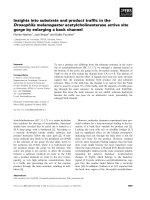
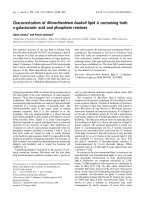
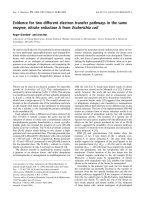
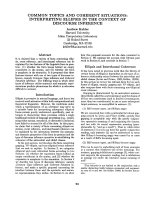
![Báo cáo khoa học: Characterization of glycosphingolipids fromSchistosoma mansoni eggs carrying Fuc(a1±3)GalNAc-, GalNAc(b1±4)[Fuc(a1±3)]GlcNAc-and Gal(b1±4)[Fuc(a1±3)]GlcNAc- (Lewis X) terminal structures pot](https://media.store123doc.com/images/document/14/rc/we/medium_xArMK8DHkQ.jpg)


